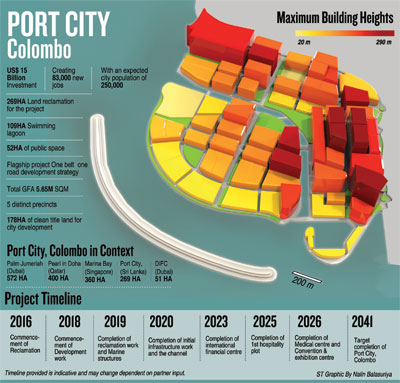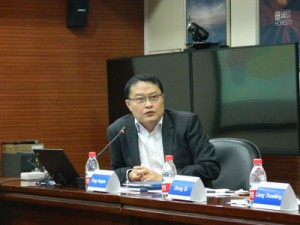News
Stop-Start Port City, OBOR flagship project, on again
The Colombo Port City (CPC) will be targeting the whole South Asian market to turn Colombo into a top metropolitan city in the world, said a senior project official.
Chief Sales & Marketing Officer- China Harbour Engineering Co. (CHEC) Ltd., Liang Thow Ming told a visiting Sri Lankan media delegation in Beijing last week that CHEC was particularly interested in an estimated 300,000 “High Net Worth Individuals (HNWIs)” in India, Sri Lanka, Pakistan and Bangladesh. “We need (to attract) only 10% of those,” he quipped, adding that the number of HNWIs in the region is projected to double during the next decade.
CHEC, a subsidiary of China Communications Construction Co., is investing US$ 1.4 billion in the project, spanning 269 hectares of reclaimed land. CHEC hopes to attract a further US$ 13 billion in secondary investments, for a combined Foreign Direct Investment of US$ 15 billion. Mr Ming said the ultimate goal was to make Colombo a top metropolitan city in the world, like Dubai, Singapore and Tokyo.
“Colombo is currently not a stopover destination for tourists, with many opting to bypass the city,” he told journalists. “It is hoped this will change because of CPC,” he added.
Some 178 hectares of the project has been set aside for real estate development, with CHEC being allocated 116 hectares on a 99-year lease, while the Govt of Sri Lanka (GoSL) gets 62 hectares.
The project is divided into five distinct precincts: Central Park Living, Financial District, International Island, The Marina and Island Living.
Among various facilities and amenities to be established under the project are an international financial centre, international school, medical centre, exhibition and convention centre, retail destinations and an integrated resort and theme park.
About 75,000 permanent residents are expected to be housed within the project. Together with a transient population which will commute daily, the CPC is estimated to have a combined population of 250,000.
CHEC claims the project will add 83,000 new jobs, most of which will go to locals.
The completion date of the project, which commenced in September 2014, is 2041, almost 25 years from now. By the end of June, 45% of the land reclamation process in the project had been completed. The process is expected to conclude towards the end of 2019, with some sections of the CPC expected to be ready for construction next year. “You don’t have to wait till you finish reclamation to start construction of buildings in the project,” he said
The project was suspended in March 2015 by the new Govt, before commencing over a year later, after a new tripartite agreement was signed between the Ministry of Megapolis and Western Development, Urban Development Authority and CHEC, on August 12, 2016.
Mr Ming said the most significant development under the new agreement was that the GoSL assumed freehold rights over the entire project.
When questioned as to what new measures CHEC took to minimise the environmental impact of the project, which was one of the concerns raised by authorities for suspending the project, Mr Ming pointed out that CHEC cooperated in the submission of a new Supplementary Environmental Impact Assessment which satisfied Sri Lankan authorities. He, however, claimed there were “a lot of misconceptions”, rather than actual damage to the environment from the project.
After completion of the land reclamation process, CHEC will proceed with the infrastructure works. Initial infrastructure works are due to be completed by 2020. “We expect to put in place some of the strategic projects during the next decade or so, with the entire project due to be completed in 2041.”
Mr. Ming stated the project fulfills the needs and aspirations of both China and Sri Lanka. “Where China is concerned, the CPC is a flagship project of the country’s One Belt One Road (OBOR) Initiative and Sri Lanka is situated right in the middle of the Maritime Silk Road. Therefore, the project forms a very instrumental epicenter of the whole route itself,” he explained.
“As for Sri Lanka, the country is looking for massive infrastructure investment and development to try and uplift the economy. This is where the project comes in with a total investment of US$ 15 billion, plus added incentives in terms of job growth and contribution to the economy,” he emphasized.

